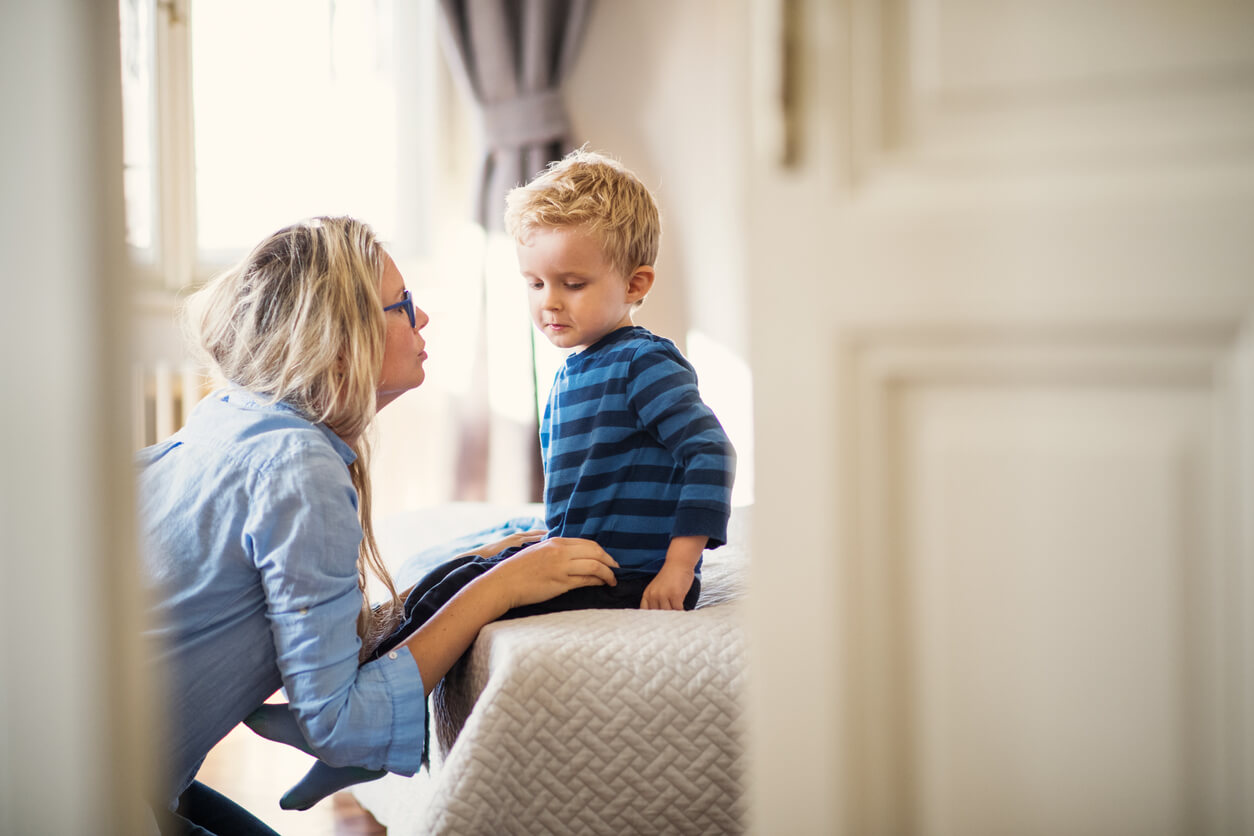Proactive Parenting: What It Is and How It's Applied

Do you know what proactive parenting means? Parents are challenged on a daily basis in relation to how to educate and raise their sons and daughters. What works? What should be done? There are as many versions of parenting as there are possible experiences.
In many cases, it’s about what works for each family and about rules that are applied “just because” but that aren’t always governed by what that child needs. From proactive parenting, we seek to educate children on values and with positive limits, which are oriented toward well-being and preventing behavior problems in the future. Let’s see what this is all about.
What is proactive parenting?
Proactive parenting has to do with certain strategies that guide parents to transmit positive values to children and adolescents. The idea is to make it easier for children to internalize them and be able to sustain them because they’ve understood their benefits.
Values guide action guidelines. They point out what’s appropriate and what isn’t, depending on the circumstances.
The fact that parenting is proactive refers to the fact that it’s not something that’s improvised or reactive. Rather, it arises from the agreement and commitment of adults. Therefore, this type of parenting is based on three fundamental pillars, which we’ll describe below.
1. Set limits
Limits imply the teaching and learning of norms that must be fulfilled and others that can be negotiated. In other words, this margin of flexibility in some rules is what allows children to experiment and explore, without implying putting themselves in danger or going against others.
Likewise, it’s about teaching that, when the rules aren’t followed, there are natural consequences. But the purpose isn’t to educate through fear, but about responsibility and commitment.
You may be interested in: Connected Parenting is the Secret to Happy Families
As for the work of parents, the key is to be consistent in their behavior (avoid “today yes, tomorrow no”) so as not to confuse the little ones and thus exacerbate frustration and anger.

2. Opt for flexible parental rules
We’re not talking about establishing rules that are constantly changing, but about the possibility of adapting them to the different family realities, according to the values that your want to share and the objectives that you want to achieve.
Proactive parenting is not following a “recipe” to the tee, but being guided by clear and well-defined values and rules in advance, which are consistent and transversal to all parenting practices of the adults in the house.
3. Carried it out with confidence and security
The teachings must be offered with certainty so that the infants understand that certain things are done for their own good. This makes sense and the idea is to provide them with tools to learn to feel confident and protected.
It also requires trusting one’s own role and accepting that how to proceed won’t always be clear, but that this isn’t synonymous with incompetence or lack of suitability to raise a child. It’s being humble and recognizing your own behaviors, limitations, and aspects to improve.
Proactive parenting is also based on a comprehensive conception of the child’s development, both physical and emotional and social. Likewise, on the understanding that each infant achieves their goals at their own pace.
Keys to exercising proactive parenting
Some of the keys to putting proactive parenting into practice are as follows:
- Be informed. It’s essential to read and seek information regarding the different stages that children go through during their growth. Knowing the challenges they face at all times will allow you to anticipate and understand what they need. This way, you can also provide the best support.
- Decide what type of parenting you want to carry out. Choosing the type of education you want to provide requires first being clear about the values you seek to convey. It’s not about educating “blindly” or on autopilot. It must be thoughtful and genuine with who you are. In this way, you can choose to work on your own parenting style, choose which experiences to stay with, and which ones to distance yourself from.
- Explain what you do so that your child understands why you do it. Especially in the case of young children, whose learning occurs mostly by imitation. This way, they’ll be able to understand the underlying value of teaching. For example: “It was nice to find a clean table for breakfast, right? So when we’re done, we pick up the cup and tidy everything up. Then your brother can find a clean table and enjoy breakfast, too.”
- Limits should always be established with respect and as soon as the opportunity presents itself. That is, whenever they’re required without waiting for the children to be “older”.
- Take care of yourself. It’s very difficult to raise children when caregivers are fatigued and collapsed. From that place, it’s easier to react poorly. So, for this reason, it’s important that parents try to organize themselves and dedicate time to their own rest and leisure.
You may be interested in: The Keys and Benefits of Positive Parenting

Limits, trust, and security: The keys to well-being
Working on these aspects is investing in the well-being and quality of life of boys and girls. It’s establishing a framework of values to which they can refer throughout their lives and from which they can establish healthy and respectful relationships.
Setting limits shouldn’t be confused with being rigid or authoritarian parents, but rather, being present and proactive. Providing reasonable limits will never be harmful, quite the contrary.
Do you know what proactive parenting means? Parents are challenged on a daily basis in relation to how to educate and raise their sons and daughters. What works? What should be done? There are as many versions of parenting as there are possible experiences.
In many cases, it’s about what works for each family and about rules that are applied “just because” but that aren’t always governed by what that child needs. From proactive parenting, we seek to educate children on values and with positive limits, which are oriented toward well-being and preventing behavior problems in the future. Let’s see what this is all about.
What is proactive parenting?
Proactive parenting has to do with certain strategies that guide parents to transmit positive values to children and adolescents. The idea is to make it easier for children to internalize them and be able to sustain them because they’ve understood their benefits.
Values guide action guidelines. They point out what’s appropriate and what isn’t, depending on the circumstances.
The fact that parenting is proactive refers to the fact that it’s not something that’s improvised or reactive. Rather, it arises from the agreement and commitment of adults. Therefore, this type of parenting is based on three fundamental pillars, which we’ll describe below.
1. Set limits
Limits imply the teaching and learning of norms that must be fulfilled and others that can be negotiated. In other words, this margin of flexibility in some rules is what allows children to experiment and explore, without implying putting themselves in danger or going against others.
Likewise, it’s about teaching that, when the rules aren’t followed, there are natural consequences. But the purpose isn’t to educate through fear, but about responsibility and commitment.
You may be interested in: Connected Parenting is the Secret to Happy Families
As for the work of parents, the key is to be consistent in their behavior (avoid “today yes, tomorrow no”) so as not to confuse the little ones and thus exacerbate frustration and anger.

2. Opt for flexible parental rules
We’re not talking about establishing rules that are constantly changing, but about the possibility of adapting them to the different family realities, according to the values that your want to share and the objectives that you want to achieve.
Proactive parenting is not following a “recipe” to the tee, but being guided by clear and well-defined values and rules in advance, which are consistent and transversal to all parenting practices of the adults in the house.
3. Carried it out with confidence and security
The teachings must be offered with certainty so that the infants understand that certain things are done for their own good. This makes sense and the idea is to provide them with tools to learn to feel confident and protected.
It also requires trusting one’s own role and accepting that how to proceed won’t always be clear, but that this isn’t synonymous with incompetence or lack of suitability to raise a child. It’s being humble and recognizing your own behaviors, limitations, and aspects to improve.
Proactive parenting is also based on a comprehensive conception of the child’s development, both physical and emotional and social. Likewise, on the understanding that each infant achieves their goals at their own pace.
Keys to exercising proactive parenting
Some of the keys to putting proactive parenting into practice are as follows:
- Be informed. It’s essential to read and seek information regarding the different stages that children go through during their growth. Knowing the challenges they face at all times will allow you to anticipate and understand what they need. This way, you can also provide the best support.
- Decide what type of parenting you want to carry out. Choosing the type of education you want to provide requires first being clear about the values you seek to convey. It’s not about educating “blindly” or on autopilot. It must be thoughtful and genuine with who you are. In this way, you can choose to work on your own parenting style, choose which experiences to stay with, and which ones to distance yourself from.
- Explain what you do so that your child understands why you do it. Especially in the case of young children, whose learning occurs mostly by imitation. This way, they’ll be able to understand the underlying value of teaching. For example: “It was nice to find a clean table for breakfast, right? So when we’re done, we pick up the cup and tidy everything up. Then your brother can find a clean table and enjoy breakfast, too.”
- Limits should always be established with respect and as soon as the opportunity presents itself. That is, whenever they’re required without waiting for the children to be “older”.
- Take care of yourself. It’s very difficult to raise children when caregivers are fatigued and collapsed. From that place, it’s easier to react poorly. So, for this reason, it’s important that parents try to organize themselves and dedicate time to their own rest and leisure.
You may be interested in: The Keys and Benefits of Positive Parenting

Limits, trust, and security: The keys to well-being
Working on these aspects is investing in the well-being and quality of life of boys and girls. It’s establishing a framework of values to which they can refer throughout their lives and from which they can establish healthy and respectful relationships.
Setting limits shouldn’t be confused with being rigid or authoritarian parents, but rather, being present and proactive. Providing reasonable limits will never be harmful, quite the contrary.
All cited sources were thoroughly reviewed by our team to ensure their quality, reliability, currency, and validity. The bibliography of this article was considered reliable and of academic or scientific accuracy.
- García Peña, John & Medina, Claudia & Botero, Juan. (2018). ESTILOS PARENTALES EN EL PROCESO DE CRIANZA DE NIÑOS CON TRASTORNOS DISRUPTIVOS*. Investigación & Desarrollo. 26. 55-74.
- Santa Cruz, Flor Fanny, & D’Angelo, Giuliana. (2020). Disciplina positiva para el desarrollo de las habilidades emocionales. Revista de Investigacion Psicologica, (24), 53-74. Recuperado en 28 de marzo de 2022, de http://www.scielo.org.bo/scielo.php?script=sci_arttext&pid=S2223-30322020000200005&lng=es&tlng=es.
This text is provided for informational purposes only and does not replace consultation with a professional. If in doubt, consult your specialist.








